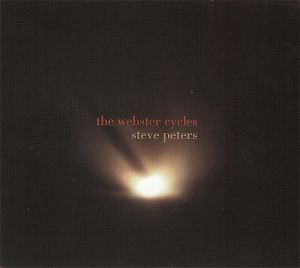1. The Webster Cycles [29:45]
J. A. Deane - Trombone
It would be all too easy
to do a straight musical review of Steve Peters'
The Webster Cycles and talk about the
interlocking trombone melodies, in terms of
timbre, timing and atmospherics. However,
while there is no doubt that this review will
traverse those areas, I prefer to treat this
review as one focusing on the material of
an artistic endeavour, rather than a purely
musicological one. The linguistic intricacies
from which this piece stems are its compositional
strength. Strangely enough, these intricacies
are left out from the CD design and I hope
I am not doing any injustice to the composer
by explaining the compositional process in
a little more depth.
Peters explains on his blog
that this piece is "a single 30-minute
piece that straddles the fence of structure
and improvisation: all of the words in the
dictionary that use only the letters A-G,
arranged in alphabetical order. Each word
is played for the length of one long breath,
and within that the letters/notes are played
spontaneously, as are dynamics, timbre, etc.
This very lush multi-tracked version is for
six trombones, all performed by the fabulous
J. A. Deane."
In some respects, the piece
could be considered a lipogram in that it
restricts itself to only certain letters.
Wikipedia describes the method as "a
kind of constrained writing or word game consisting
of writing paragraphs or longer works in which
a particular letter or group of letters is
missing," In this case, Peters has excluded
all letters after G in order to limit the
notes to those of the western scale. Musically,
this lipogrammatic choice does not restrict
the piece as the technique normally would.
What Peters does not mention
is the musical implications that come from
the simple choice to perform the words in
alphabetical order. For example, here is a
collection of words from early in the dictionary
in alphabetical order. Abaca, aback, abacot,
abactinal, abaction, abacus. What is immediately
obvious is that the first four letters of
each word are the same. Compositionally speaking,
this means that the first few notes of each
phrase in the piece will also be the same,
with the tail end of each phrase acting as
a shifting variant. The beauty of this is
that there is a melodic cohesion; the phrases
seem to be connected to one another (by their
beginning notes) as we follow a slow transition
through the programmatic musical lexicon.
This may seem to be an extremely avant-garde
compositional technique, but given Peters'
background in art installations it is not
far removed from his other creations.
As this is a musical piece,
some notes must be devoted to the performance
of The Webster Cycles by J. A. Deane.
The liner notes indicate the piece may be
performed by a range of ensembles and instruments,
but this recording employs the use of six
multi-tracked trombones, each played by Deane.
The benefit of one performer multi-tracking
the composition (rather than a multiple person
ensemble) is twofold. Firstly, there is the
cohesion of timbre. Though Deane employs different
playing techniques (including wind effects
by blowing through the instrument), the use
of a single player eliminates the clashes
that can sometimes occur through the different
playing styles of different musicians. Secondly,
it gives the performer complete control over
the performance of the piece, something that
Peters has explicitly left up to the instrumentalist.
Since he is in control of all six trombone
parts, he has the artistic direction of where
to double, interject with, or echo himself.
J. A. Deane's performance
is flawless, emphasising the smooth transitional
nature of the composition. The trombones,
when coupled with reverb effects in post-production,
enact a flowing musical landscape, shifting
step by step as nature does through the seasons.
The sheer musicality and depth of the performances
makes me very interested to hear the piece
performed with other instruments, if only
to compare the impact of timbre upon concept:
a possibility Peters has left open throughout
the compositional process.
For contemporary artists
of all disciplines, this single-track release
will intrigue your creative senses, not only
in the conceptual framework of the composition,
but in the stunning execution of 'thinking
outside the box', both by composer and performer.
For listeners who may not be so interested
in the compositional process, it is worth
contemplating the piece in terms of the great
challenge of performing a piece that can be
constantly shifted and expanded. This is an
album I would prefer to hear in an abandoned
warehouse, in true stereo. For it seems that
only then would we grasp the solitary nature
of such an exquisite and intricate composition.
Sam Webster
